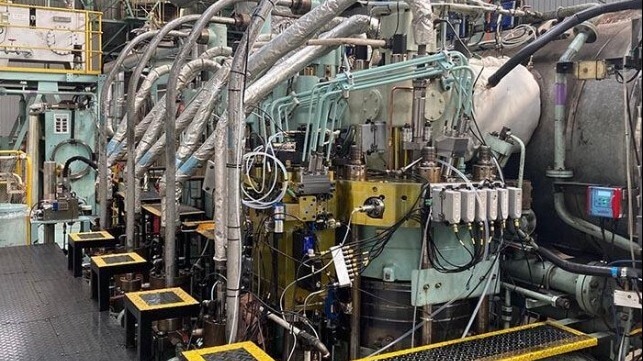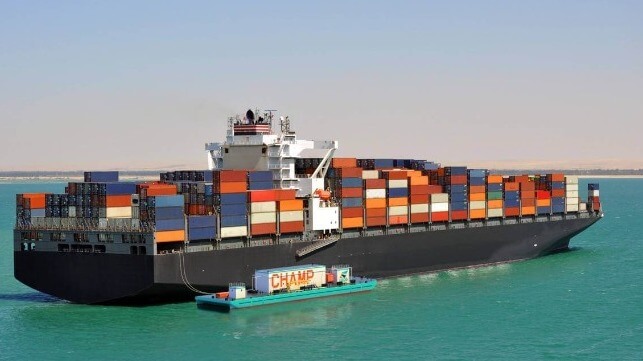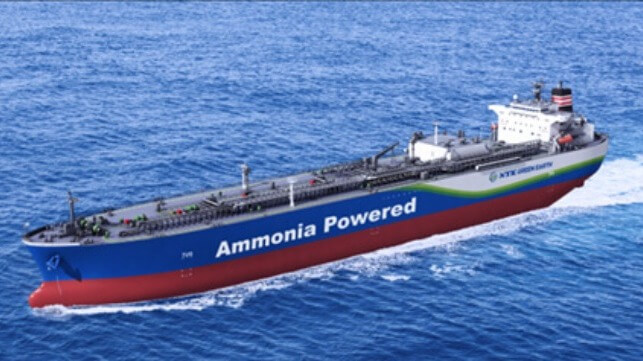ALTERNATE FUELS
Mitsui Achieves First Hydrogen Combustion with a Large Marine Engine

Japan’s Mitsui E&S is reporting that it successfully achieved hydrogen combustion of a large marine two-stroke engine making a key milestone in the development of hydrogen as an alternative fuel. Previously the tests have focused on hydrogen derivates such as ammonia, with the company which worked in conjunction with MAN Energy Solutions reporting that this provides critical information toward moving directly to hydrogen as a fuel.
During the test, one of the four cylinders in a MAN B&W two-stroke LNG-fired gas injection engine was converted to a hydrogen operation. The other cylinders continued to be fired with conventional fuel as a base case for comparison. High-pressure hydrogen was supplied to the cylinder from the hydrogen gas supply facility previously developed and demonstrated by Mitsui E&S.
They operated the cylinder and were able to achieve 100 percent load fueled by hydrogen load without any problems such as hydrogen leakage. They are reporting that the hydrogen fuel ignites easily but requires proper combustion control. The company succeeded in covering the equivalent of 95 percent of the heat value with hydrogen fuel, and the cylinder pressure curve was equivalent to that of the other three cylinders operated with conventional fuel. The company also confirmed that the hydrogen gas supply facility is capable of the stable supply of high-pressure hydrogen required for the engine. The five percent emissions originated from pilot fuel used during the testing.
Mitsui is a licensor of MAN with the German engine company reporting it worked closely with the Japanese company on the research project. Commenting on the results, they highlighted the “food for thought” from the results while calling it “a very interesting project” and saying they were very happy with the results achieved.
"This proves the advantages and the flexibility of two-stroke engine technology, and means that we are now also prepared for the future, not only for hydrogen derivatives but also for hydrogen as a fuel,” said Bjarne Foldager of MAN Energy Solutions.
MAN highlights that it is currently pursuing both the two- and four-stroke segments related to hydrogen. They said they would be evaluating the results while calling it a milestone for hydrogen. Mitsui E&S said it is the latest step in efforts for the early launch of hydrogen-related businesses in the maritime industry.
EBDG and Wärtsilä Team Up on Methanol-Fueled Power Barge

Seattle-based naval architecture firm Elliott Bay Design Group (EBDG) has reached an agreement with Wärtsilä to develop a barge-mounted cold ironing system that runs on methanol. The announcement confirms an arrangement the firms reached late last year.
EBDG's Clean Harbor Alternative Mobile Power (CHAMP) system is designed to provide auxiliary power in port, without grid infrastructure. The CHAMP barge runs with a clean-burning methanol-powered engine, and can provide offboard electricity where conventional shore power is not available. This allows the vessel to shut down its auxiliary engines and reduce in-port emissions.
For the port and surrounding community, this is an advantage from an air quality standpoint, but also alleviates pressure on the local electrical grid. Merchant ships can draw megawatt-scale loads, and delivering that much power often requires costly grid improvements.
“We are pleased to partner with Wärtsilä in bringing this innovative patent-pending solution to the market. The CHAMP barge project represents a significant stride toward tackling the most daunting challenges in curbing port emissions,” says Mike Complita, Principal in Charge at EBDG.
CHAMP will use a Wärtsilä 32 engine adapted to run on methanol, along with Wärtsilä exhaust treatment and fuel-handling systems. It will be able to provide 6-16 MW of power, and will be able to meet ships wherever they are in the harbor - whether alongside the pier or at anchor. EBDG envisions a second role for the barge as a recharging station for battery-electric harbor vessels, like tugs and small workboats.
For the operator, a floating power supply offers compliance advantages: it falls under U.S. Coast Guard regulations, and does not need the permitting process required for shoreside facilities. It is also designed to be compact - just 225 feet long - in order to fit well into the harbor operations of America's busiest ports.
NYK in Effort to Develop N2O Removal System for Ammonia-Fueled Ships

A Japanese partnership between Hitachi Zosen Corporation and NYK (Nippon Yusen Kabushiki Kaisha) has been selected in a new research competition to develop the devices needed to eliminate nitric oxide (N2O) emissions when ammonia is heated and burned. While the industry is anxiously anticipating the introduction of ammonia as an alternative fuel to address the challenges of decarbonization, NYK highlights there is also a critical need to eliminate N2O emissions.
Japan’s New Energy and Industrial Technology Development Organization (NEDO) launched in November 2023 the next round of its ongoing efforts to develop green technologies. Hitachi Zosen and NYK were selected as a “Next-Generation Ship Development,” by NEDO for their proposal to develop what they are calling an N2O Reactor to be employed on ammonia-fueled ships as a catalytic removal system for N2O. They will be receiving funding from NEDO as part of Green Innovation Fund Projects.
Hitachi Zosen has a strong track record and know-how in catalytic technology, including the development of a marine vessel selective catalytic reduction (SCR) system for removing nitrogen oxides (NOx) in marine engines. The company will be responsible for developing the device as well as the catalysts and control systems that will first be developed for a 2-stroke engine.
The companies highlight the critical importance of controlling N2O emissions. N2O's global warming potential they note has been estimated at about 300 times that of CO2. Therefore, the companies said reducing N2O emissions is essential in order to realize ammonia-fueled ships that are highly effective in reducing GHG emissions.
NYK will be working with Hitachi Zosen to optimize the equipment layout for installation aboard ships and ClassNK will be reviewing and contributing its expertise. It will perform the required verifications of the design. The project will be launching this year and is scheduled to run through 2027.
NYK plans to install the N2O Reactor developed by Hitachi Zosen on an ammonia-fueled ship scheduled to be delivered in November 2026. NYK will also conduct safety and performance verification on demonstration voyages.
As a shipping company, they have been working to develop opportunities for ammonia as a fuel and for the transport of ammonia. NYK has already ordered several ammonia-ready transport ships and now looks to further develop its lead in this emerging segment.
No comments:
Post a Comment